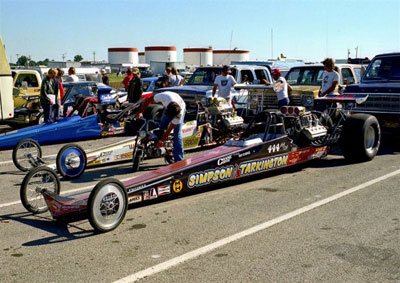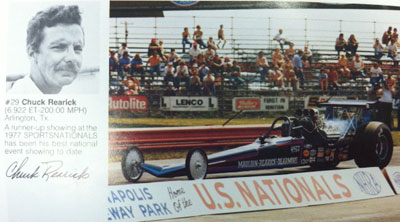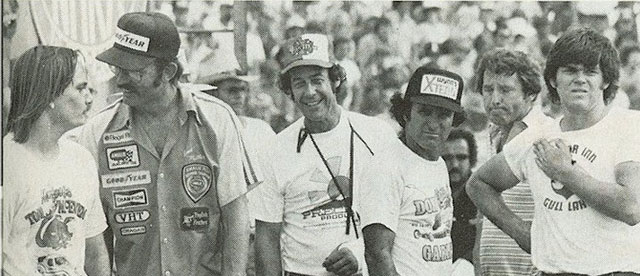

My favorite time of year(book)
 |
Whether you’re lost in the woods or tortuously filling and tying off scores of water balloons for your 4-year-old grandson’s “swim party,” it’s good to know you’re not alone, and when it comes to admiration for the 1977 NHRA U.S. Nationals Yearbook profiled here last Friday, it’s plenty clear that I’m not all wet.
I probably helped set some kind of record for drag fans racing to attics and tearing through old boxes of drag mags in search of their copy of the treasured tome for a chance to once again revel in the words and photos of its creators.
I heard back from interview subject John Plisky, who was moved to tears by my retelling of his dad’s legacy – I took a quiet moment to think about both of them Saturday, on the anniversary of the senior Plisky’s passing – and heard from another of his children, mystery writer and columnist Jennifer Plisky Vido, who got me all misty eyed. “On behalf of my family,” she wrote, “I want to thank you for the beautiful article you wrote about our father. Your timing is impeccable. What a perfect way in which to pay tribute to his memory. I know he would have been honored by your kind words."
I also heard from East Coast photo ace Norman Blake, who reported that Richard Pasley, one of the photographers for the yearbook, had provided photos for National DRAGSTER’s Summernationals coverage a few times, and he promised to have Richard get in touch to tell his side of the story.
Reader Craig Hughes, who got this whole thing kicked off by loaning me his copy (it’s in the mail back to you, Craig!), expressed a common thought of the group. “I am disappointed that the person who did all of the work and took a financial risk is no longer with us,” he wrote. “I'm glad to hear from his son that he felt people enjoyed his efforts. He did do an excellent job, and you can tell he had a great love of drag racing and the Nationals from the book. I would have bought his book each year.”
 |
I also heard from former NHRA Eastern Region Tech Director Jim Fagan, who is the guy pictured with Bill Jenkins in the image from the book at right that I printed last week. “It's quite a pleasure to see the picture in your column today of Bill Jenkins working on the race car,” he wrote. “I happen to have that same publication because the guy in the blue shirt working with him is me! Of course that was 30-plus years ago, and we've both changed somewhat -- my hair especially changed color. Thanks for bringing back some more memories.” Because he was working with “Grump” at that race where Jenkins driver Larry Lombardo famously crashed the team’s Monza when it cut a valve stem, leading fellow competitor Ronnie Manchester to loan them his car, I asked Fagan to gather his memories of that pretty amazing moment in our sport’s history to share with us at a later date.
More praise for the book …
Dave Cox: “I bought that '77 U.S. Nationals yearbook and still have it. It's a great book. Now I know why it wasn't published every year. Throughout the ‘70s, I had been trying to make my way to from Virginia to Indy. I remember ordering that book because it was the last 32-car field, and I had missed it. The book continued to inspire me to get to Indy, though, when I'd leaf through it. After not looking at it for a few years, it was always a treat to find it again. In about '91, I was living in Atlanta. A buddy and I left the Braves game late on a Thursday night in an old motorhome. We flipped a coin to see if we were going to Darlington or Indy for the weekend. Indy won out, so I finally made it. Stayed in the campground that I saw in the yearbook, and although things had calmed down considerably, it was way cool.”
Richard Pederson: “Throughout the history of racing -- especially drag racing -- there have been stories such as this, of those who give up a large part of their well-being, fortune, even family and marriage to pursue their dream. Although John Plisky did not have the financial gain and perhaps a job he had hoped, he did something that touched so many that he never knew and did indeed set the bar perhaps too high. I have seen this book somewhere, thought it was great, have never seen another, and wondered, then and now, 'Why?' So your story has brought back some memories.”
Billy Donahoe: “I happen to have one. Super Stock & Drag Illustrated ran an ad for it sometime in '78, I guess. I snapped it up as quick as I could. It is I think the best coverage of a national event ever written. The photography is outstanding, but it's the writing of the story that makes it priceless. Never in my wildest dreams would I have thought to compare it to a medieval contest, but it just seemed to fit. I've never been an autograph hound, but to get all 96 qualifiers’ signatures is a feat in itself.”
Second-generation racer Wes Tarkington wrote directly to Plisky and copied me on his correspondence. “Just read Phil Burgess’ piece on the ’77 yearbook … brought tears to my eyes. I was just 6 years old when the 1977 event took place (even more remarkable is that my wife, Aspen, also a drag racer, had not even been born yet). As it was a yearly trek from the Dallas area to Indy, my family attended the event. This particular year was especially memorable because it was the first and only U.S. Nationals we attended as competitors. My father, Dennis, was partners with Watus Simpson campaigning a Pro Comp car (AA/DA No. 444). Sadly, we did not qualify. Seems those aluminum Donovan blocks and three-speed Lencos were no match for our $57 iron 392 blocks and the outdated two-gear Lenco. Many of our Division 4 friends made the field, though. We stayed at the track until the very end on Monday.
 |
“My parents ordered the yearbook for me. I recall bugging them for months on end as to when it was going to arrive. Part of me was insanely curious if there was a photo of our Chicken Lips Simpson & Tarkington dragster included or if I was in the right place at the right time watching my family and team work on the car. Maybe even a glimpse of me in awe of Beadle, Prudhomme, Muldowney, Garlits, or some of my other heroes from my childhood. When the yearbook finally arrived, I ripped open the packaging and spent the next decade thumbing through the photos and rereading each page, virtually memorizing the publication. Fairly certain, too, that there was more than one book report covering your dad’s work at one of the schools I attended in Dallas, Kansas City, and Riverton, N.J.
“Somewhere in the house or the race shop, packed away in a container, rests my well-worn copy of the yearbook. If not for the 105-degree heat today, you would find me in the attic searching for the book. We are expecting our first child in February; the yearbook will most certainly find its way into the nursery and into the hands of our future drag racer/hockey player. Your father’s work (and yours, as well) was a huge part of my life growing up in the sport my family chose. To say it meant a great deal to me and others would be a gross understatement.”
Mike Hedworth: “I can't agree with you more about your feelings of this book. Not only do I have a copy, the ‘77 Nationals was first one I had attended. I have been to three others since. Like you said, this book gives you the whole feeling of the experience because that is what Indy is, an experience instead of just a race. I would like to thank you for bringing this up. I think I will pull it out of my bookcase tonight and have another look at it.”
David McGriff: “I still have the copy I bought at the racetrack the following year. As I recall, they had a table set up along the chain link fence at the old west side walk-in entry. I can remember as clear as a bell walking by there and spending the last $10 bill I had on that book (the $3 change went a lot further in those days) but I still had to beg my buddy to buy me one of those Italian sausages you mentioned in an earlier column. Wow, What great fun! My issue of that book remains one of my favorites and it is proudly displayed next to my Carl Hungness Indy 500 yearbooks, which it always reminded me of. Looking through it, it still has the old insert in the back cover for ordering other copies. The photos are top notch and every one I show it to wants to know where I got it.”
Steve Wilhelm: “As I sat down at my computer this morning and looked forward to reading the DRAGSTER Insider, I thought about my copy of the 1977 NHRA U.S. Nationals Yearbook on the shelf. Since Indy is a few days away, I was going to look through my well-worn copy of the yearbook and remember the trips to the U.S. Nationals I took with my wife in the late ‘70s and early ‘80s. I opened your blog, and there was your column about the yearbook. I believe that the yearbook is the best description of a drag racing event that has ever been published. I look at the yearbook every year around U.S. Nationals time. My favorite part of the yearbook is the pictures of all the qualifiers and class champions. A lot of these racers are no longer with us. John Plisky can be proud of his father's efforts. No, my copy is not for sale.”
Like Tarkington, Chuck Rearick and his team were part of the Indy Pro Comp action that year – he qualified 29th after runner-upping earlier that year at the SPORTSnationals – and backed up something that Todd Veney had told me but was unable to confirm, that all of the qualifiers listed in the book got a free copy from Plisky. That’s cool.
 |
“Your article motivated me to pull out this great publication and blow off the dust,” he wrote. “It sure brought back some fond memories such as 60-plus cars (I believe) from all over the country trying to qualify for a 32-car Top Fuel field and the same amount in Pro Comp. During Pro Comp qualifying, there would be two cars on the starting line, two waiting to do a burnout with the motors running, and two more ready to fire. It was like someone put a pill down on the ground, just added water, and ‘poof’ another car would appear.
“On qualifying days, we would get in line outside the track around 5:30-6ish for a 7 a.m. gate opening. Some of the best racing I ever saw was once the gate opened, everyone racing to their trailers, unloaded the cars and hauled ass to the staging lanes to get a good spot for first round of qualifying. We would prepare the car and warm it in the staging lanes -- pretty crazy, but great. After the first round of qualifying, we got right back in line, and unless we had major damage, got the car prepped for the second round of qualifying. We were in line with the car up on jacks, alongside Dennis Baca. He asked us if ours was one of those alcohol cars that didn’t need any maintenance. Indy was always an endurance contest as well as a happening and true melting pot of racers. We didn’t qualify until the last round of qualifying, so I didn’t get my picture taken and autograph signing until just before first round. At the time, I was a young 37 years old. For the record, we got beat first round by Don Woosley. I raced him earlier that year at the Cajun Nationals and won on a holeshot, a tough task against Woosley, so we were 1-1 against him. Going through the book and remembering all the Pro Comp guys I raced with and against was great. Following is an update on some of the qualified Pro Comp cars, with page number:
Page 164, Dale Armstrong – Still active in car restoration in California
Page 164, Ken Veney – You know where he is
Page 165, Billy Williams – Passed away some time ago from injuries in a Funny Car crash
Page 165, Brad Anderson – Still active as a manufacturer
Page 166, Dave Settles – Still involved building fuel pumps. I see him every year at the Geezer luncheon in Dallas. We had some good battles in Division 4 racing that year
Page 166, Pat Cress – Unknown
Page 167, Ron Boggs – Unknown
Page 167, Simon Menzies – Last I heard, he was back in California
Page 168, Marlis Williams – Unknown. I think he and his partner Dick Bohl only raced one or two years. Had to race him first round at the SPORTSnationals in Bowling Green and won
Page 168, Bob Chipper – Unknown Died July 10
Page 169, Gary Southern – Alive and well. He had an Arias “hemi-Chevy” for power
Page 169, Jeff Rapp – Unknown
Page 170, Don Woosley – Passed away a few years ago
Page 170, Butch Osmon – Moved up to Top Fuel driving for Jim and Alison Lee. We raced him second round at Bowling Green and won
Page 171, Don Gerardot – Still active as a manufacturer
Page 171, Bill Wallace – Unknown
Page 172, Lou Gasparrelli – Just recently passed away
Page 172, David Beaty – Unknown
Page 173, Kenny Cook – Unknown. Had the only small-block Chevy to qualify. There was one more Chevy car entered by Al Mallory, who did not qualify. He now runs a Jr. Fuel car
Page 173, John Davis – Unknown
Page 174, Scott Weney – Still active as a manufacturer
Page 175, Mark Niver – One of the all-time really good guys and a good friend. Passed away prematurely last year
Page 176, Wayne McMurtry – Retired to a life of ease with NHRA. Another of the good guys
Page 175, Vern Moats – Still active with a TAFC
Page 176, Wild Wilfred Boutilier – Dropped out of sight after ‘77 or ‘78
Page 176, Bogie Kell – Unknown
Page 177, Jim Archer – Still active in nostalgia racing with Gene Adams in NTF or J/F. I usually get to visit with him at the reunions. Beat me in the SPORTSnationals final in Bowling Green
Page 177, Tom Ridings – Unknown
Page 178, Chuck Rearick - Still active with a Jr. Fuel car. Was partner with Pic Mauldin, who passed away in 2006, and John Dearmore, who is still active with a cackle car
Page 178, Al Kenny – Last I heard, was still an active bracket racer
Page 179, Mike Kosky – Still active in TAD
Page 179, Jeff Richardson – Unknown
I’m sure that we’ll hear more about people on Rearick’s list, but I did recently hear from Menzies, whom I profiled here way back in December 2007. He’s involved in the aerospace industry, making, among other things, cowlings for commercial and business jets with customers like Airbus, Boeing, Cessna, and Lear. "When you look out the window on your next trip and see the large circular silver ring on the inlet of any jet engine, remember it came with a little drag racing influence right here from sunny California," he noted.
 |
In the spirit of the topic, Menzies passed along the photo above, taken at the 1977 U.S. Nationals, showing a group of racers around Dale Emery, who was back at the track after breaking his arm in that wild qualifying accident. That’s Menzies at far right, next to “Big Daddy” Don Garlits. Next to Garlits is Emery, then "Waterbed Fred” Miller, chatting with crewman to the stars, Pat Galvin.
“Everyone was relieved to see [Emery] at the track the next day with only a broken arm,” Menzies recalled. “Looks like I was keeping company with some awesome folks back then.”
OK, and speaking of Indy, that’s where I’m heading Thursday, so, unfortunately, no new column Friday, and because I’m traveling back Tuesday, probably no column then either, so I might not get another column together until the Friday after that (Sept. 9). Oh, the horror.
Before I go, I want to acknowledge the passing of several good friends of drag racing whom we lost in the last couple of days. During the weekend, Dave McClelland dropped me a line to let me know about the passing of Ray Harris of Shreve Automotive fame, one of the Southwest’s most ardent supporters of our sport. No sooner had I posted an obituary for Harris than Tom McEwen called to let me know of the passing of Bob Creitz, who was a good friend to so many people in our sport and one heck of a talented tuner. Also this past weekend, I learned of the passing Thursday of Judy McCormack, who with her husband, Jack, ran some pretty quick stockers in the last couple of decades. A tough week already.



















































